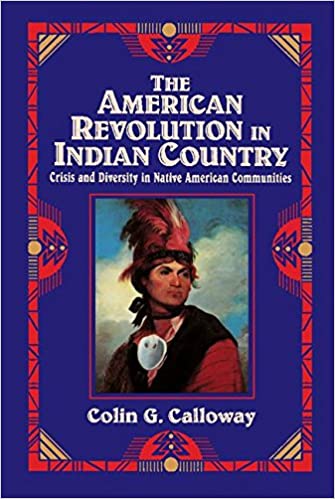
THE AMERICAN REVOLUTION IN INDIAN COUNTRY
THE AMERICAN REVOLUTION IN INDIAN COUNTRY
By Colin G. Calloway. Published 1995 by Cambridge University Press. 327 pages. ISBN: 0-521-47149-4 hardback.
Most of the available books on the American Revolution focus on the usual combatants: Colonists, the British Empire, France, Germany and, to a lesser extent, Spain. Colin Calloway has filled an enormous gap in our studies with this comparatively short coverage of the role played by Native Americans during the conflict.
Focusing on eight different native communities, Calloway explains how the Revolution renewed, exacerbated, and initiated various conflicts between the natives themselves, as well as with the colonists. For example, the Iroquois Six Nations became hopelessly divided as the Oneidas and Tuscaroras tended to side with the colonists, while the other four sided with the British. Even this is an over-simplification, as there were a number of Oneidas who openly supported the British. The same divisions occur throughout the Indian world as tribe after tribe becomes duly involved in the conflict. The Iroquois were only one group of people that were displaced from their native homelands and, in some cases, annihilated by the Revolution. As the author notes: “By the end of the Revolution, Shawnees from Ohio were living in Missouri, New England Indians were living among the Oneidas in New York, and there were two Iroquois leagues: one in New York State, the other on the Grand River in Ontario.” (preface, pg. viii)
The author also informs us just how dependent most native communities had become on colonial goods and trade by 1775. The afore-mentioned Oneidas provide us with an excellent example: “Oneida Indians cooked in metal kettles and frying pans, ate with spoons from pewter plates, at meals illuminated by candlesticks, sipped out of teacups filled from teapots, served beverages from punchbowls, combed their hair with ivory combs while looking in glass mirrors, wore white flannel breeches, used silk handkerchiefs, and lived in ‘a very large framed house [with a] chimney at each end [and] painted windows.” (prologue, pg. 12) Other tribes lived in similar fashion.
Calloway does not limit himself to a discussion of which tribes/nations supported the colonists and which side supported the British, as one might expect. HIs approach is much broader as he delves into the various experiences the natives had with the land, with each other and with the various white settlers. The time period before the Revolution is pivotal, and Calloway covers it extremely well. What I found to be especially fascinating is the fact that, prior to the Revolution, many of the native peoples were living somewhat harmoniously with whites all over the colonies, albeit with some uncomfortable undertones. While their relationships were sometimes strained and occasionally erupted into violence and warfare, both natives and colonists often found that they could cohabitate in ways that were mutually beneficial.
The Revolution changed this relationship forever. Countless massacres, changing loyalties and broken promises made these relationships no longer viable. As more and more whites forced their way onto Indian lands during and following the war, it became increasingly impossible for whites and natives to cohabitate, and, as Calloway makes abundantly clear, the new American nation had no use for the “backward” natives. What followed was a century of warfare, culminating in the 1890 battle of Wounded Knee.
The Revolution itself proved to be a disaster for the various Indian nations, even those that sought neutrality during the conflict. Tellingly, Calloway also covers the period immediately following the American victory, a time in which racial stereotypes and discrimination assumed a pivotal role in the new American nation, which increasingly began stereotyping the natives as brute savages while ignoring the role many tribes had played in securing the American victory.
Categories: Book Reviews
